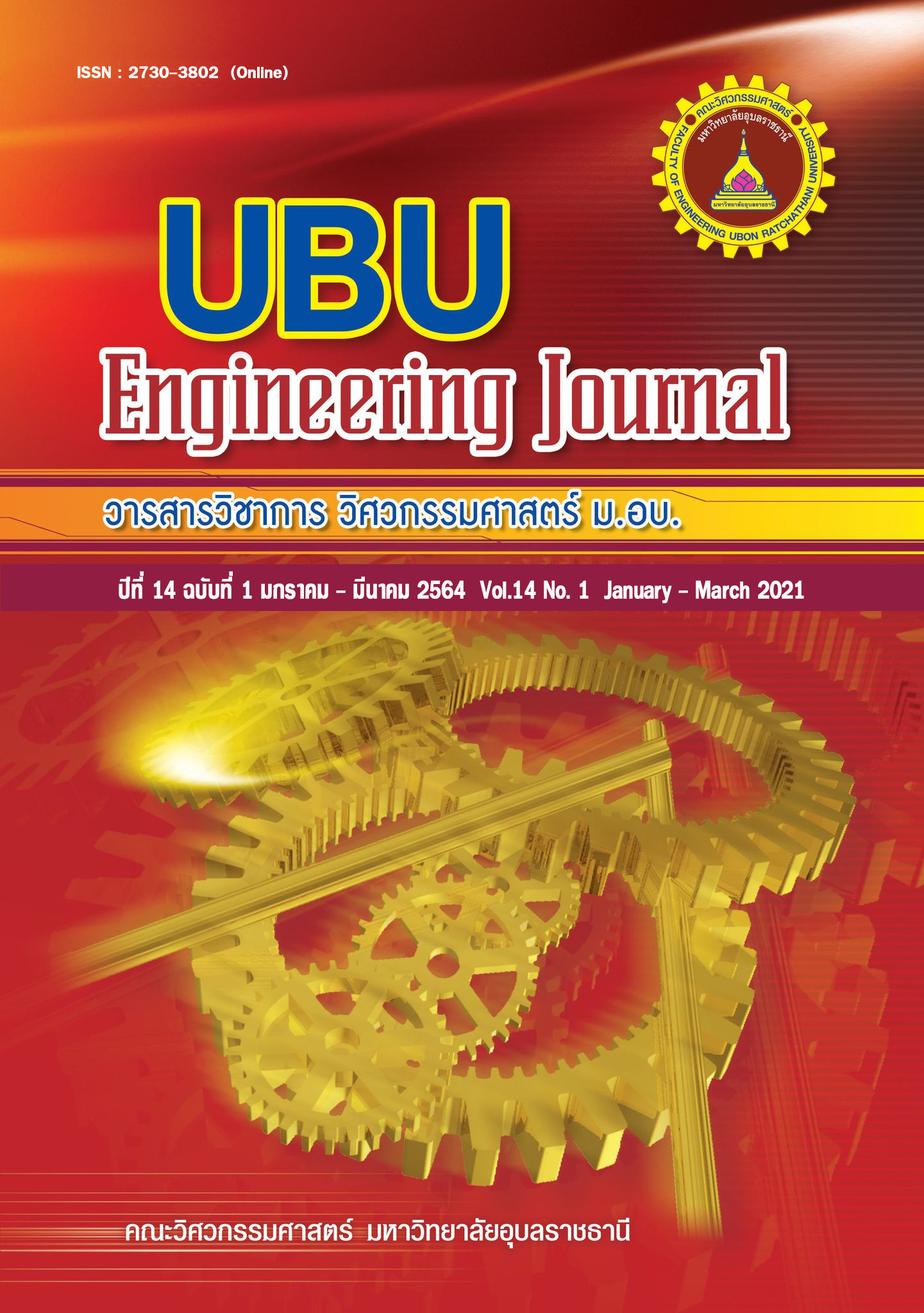Inhibition of the fungus Rhizoctonia solani by using caffeine from Arabica coffee pulp
Main Article Content
Abstract
The objective of this study was to explore the potential growth inhibition of Rhizoctonia solani (R. solani) using caffeine from Arabica coffee pulp with respect to different concentrations of caffeine. R. solani commonly causes seed rot, damping-off, sheath blight, and leaf blight. In this study, R. solani was cultured in the laboratory scale using Potato Dextrose Agar (PDA) plates in the presence of caffeine concentrations of 20, 40, 60, and 80 mg/L for 10 days at room temperature. The results showed that caffeine from Arabica coffee pulp gave significant difference in the growth inhibition rate of R. solani, as compared to the control condition (P<0.01). Caffeine from Arabica coffee pulp at the concentrations of 20 and 40 mg/L gave the average growth inhibition rates of R. solani of 15.3±4.2% and 58.8±3.5%, respectively. Besides, the concentrations of 60 and 80 mg/L resulted in the average growth inhibition rate of R. solani of 100.0±0.0% for both conditions, as no growth of R. solani could be found on the PDA plates. These results could be explained by the allelopathic potential of caffeine on inhibiting the growth of plant pathogenic fungi. This study provided a development of efficient method for growth inhibition of R. solani in which focused on the use of natural substances, as the caffeine content in Arabica coffee pulp was used. This Arabica coffee pulp was considered as an agricultural waste.
Article Details
References
[2] พีระวรรณ พัฒนวิภาส, ทัศนาพร ทัศคร, ธารทิพย ภาสบุตร, ศิวิไล ลาภบรรจบ, อ้อยทิน จันทร์เมือง. การศึกษาประสิทธิภาพของสารป้องกันกําจัดโรคพืชในการป้องกันกําจัดเชื้อรา Rhizoctonia solani สาเหตุโรคพืช. ใน: กลุ่มบริหารโครงการวิจัย สำนักวิจัยพัฒนาการอารักขาพืช (บรรณาธิการ) รายงานผลงานวิจัยประจำปี 2554 เล่ม 2. จังหวัดนนทบุรี: โรงพิมพ์ชุมนุมสหกรณ์การเกษตรแห่งประเทศไทย จำกัด; 2555. หน้า 788–795.
[3] ภรณี สว่างศรี. การคัดเลือกและการผลิตมวลชีวภาพเชื้อรา Trichoderma harzianum Rifai เพื่อใช้ควบคุมโรคใบไหม้ของถั่วหรั่ง (Vigna subterranea (L.) Verdc.) ที่เกิดจากเชื้อรา Rhizoctonia solani Kuhn. วิทยานิพนธ์วิทยาศาสตร์มหาบัณฑิต สาขาโรคพืชวิทยา มหาวิทยาลัยสงขลานครินทร์. จังหวัดสงขลา; 2546.
[4] สำนักระบาดวิทยา. สรุปรายงานการเฝ้าระวังโรค ประจำปี 2560. จังหวัดนนทบุรี: กรมควบคุมโรค กระทรวงสาธารณสุข; 2560.
[5] สุมนา ราษฎร์ภักดี, วิเชียร ศรีหนาจ, วัฒน์สิทธิ์ ศิริวงศ์. ปริมาณสารกำจัดศัตรูพืชโพรฟีโนฟอสที่ตกค้างในพริกจากตำบลหัวเรือ จังหวัดอุบลราชธานี และความเสี่ยงจากการบริโภค. วารสารวิชาการ วิศวกรรมศาสตร์ ม.อบ. 2558; 8(1): 115–122.
[6] Patra S. Biotransformation of caffeine to value added products. Ph.D. Dissertation, University of Mysore. Karnataka, India; 2007.
[7] Von Enden JC, Calvert KC. Review of coffee waste water characteristics and approaches to treatment. PPP Project, Improvement of Coffee Quality and Sustainability of Coffee Production in Vietnam. German Technical Cooperation Agency (GTZ). 2002: 1–10.
[8] Nonthakaew A, Matan N, Aewsiri T, Matan N. Caffeine in foods and its antimicrobial activity. International food research Journal. 2015; 22(1): 9–14.
[9] Gloria MBA, Almeida AAP, Engeseth N. Chapter 10: Antimicrobial activity of coffee. In: Farah A. (eds.) Coffee: Consumption and Health Implications. UK: The United Kingdom by CPI Group (UK) Ltd; 2019. p. 234–254.
[10] Hollingsworth RG, Armstrong JW, Campbell E. Caffeine as a repellent for slugs and snails. Nature. 2002; 417: 915–916.
[11] Kim YS, Uefuji H, Ogita S, Sano H. Transgenic tobacco plants producing caffeine: A potential new strategy for insect pest control. Transgenic research. 2006; 15: 667–672.
[12] Laranja AT, Manzatto AJ, de Campos Bicudo, HEM. Effects of caffeine and used coffee grounds on biological features of Aedes aegypti (Diptera, Culicidae) and their possible use in alternative control. Genetics and molecular biology. 2003; 26(4): 419–429.
[13] Nathanson JA. Caffeine and related methylxanthines: Possible naturally occurring pesticides. Science. 1984; 226(4671): 184–187.
[14] Sugiyama A, Sano CM, Yazaki K, Sano H. Caffeine fostering of mycoparasitic fungi against phytopathogens. Plant signaling & behavior. 2016; 11(1): e1113362–1–7.
[15] Kumar S, Kumar A, Chand G, Lal M, Kumar R. Dynamics of mycelial growth and sclerotia production of Rhizoctonia solani Kuhn (AG1-IB) of Urdbean. Ecoscan. 2014; 8(3&4): 273–277.
[16] ศิรประภา ชัยเนตร, รุ่งนภา เขียววิจิตร, วรวุธ ชัยเนตร, ครรชิต เงินคำคง. การศึกษาประสิทธิภาพสารสกัดคาเฟอีนในเปลือกกาแฟเป็นสารชีวภัณฑ์. รายงานฉบับสมบูรณ์ มูลนิธิโครงการหลวง มหาวิทยาลัยเทคโนโลยีราชมงคลล้านนา. จังหวัดเชียงใหม่; 2562.
[17] ปาณัสม์ บูรณะกร, ธัญวรัตม์ เชื้อเจ็ดตน. การศึกษาความเป็นไปได้ในการใช้คาเฟอีนจากกากกาแฟและกากชาเป็นสารชีวภัณฑ์. ปริญญานิพนธ์วิศวกรรมศาสตรบัณฑิต สาขาวิชาวิศวกรรมสิ่งแวดล้อม มหาวิทยาลัยเทคโนโลยีราชมงคลล้านนา. จังหวัดเชียงใหม่; 2561.
[18] Pengnoo A, Kusongwiriyawong C, Nilratana L, Kanjanamaneesathian M. Greenhouse and field trials of the bacterial antagonists in pellet formulations to suppress sheath blight of rice caused by Rhizoctonia solani. BioControl. 2000; 45(2): 245–256.
[19] Vincent JM. Distortion of fungal hyphae in the presence of certain inhibitors. Nature. 1947; 159: 850–850.
[20] Abdel-Ghany TM, El-Sheikh HH. Mycology. California, USA: OMICS Group eBooks; 2016.
[21] Wang C, Pi L, Jiang S, Yang M, Shu C, Zhou E. ROS and trehalose regulate sclerotial development in Rhizoctonia solani AG-1 IA. Fungal biology. 2018; 122(5): 322–332.
[22] Anaya AL, Cruz-Ortega R, Waller GR. Metabolism and ecology of purine alkaloids. Frontiers in bioscience. 2006; 11: 2354–2370.
[23] El-Refai IM, Moustafa SMI. Allelopathic effect of some cruciferous seeds on Rhizoctonia solani Kuhn and Gossypium barbadense L. Pakistan journal of biological sciences. 2004; 7(4): 550–558.
[24] Cheng F, Cheng Z. Research progress on the use of plant allelopathy in agriculture and the physiological and ecological mechanisms of allelopathy. Frontiers in plant science. 2015; 6(article 1020): 1–16.
[25] Singh HP, Batish DR, Kohli RK. Allelopathy in agroecosystems: An overview. Journal of crop production. 2001; 4(2): 1–41.
[26] Tanti AJ, Bhattacharyya PN, Sandilya SP, Dutta P. Allelopathic potential of caffeine as growth and germination inhibitor to popular tea weed, Borreria hispida L. Current life sciences. 2016; 2(4), 114–117.
[27] Zhu C, Lei M, Andargie M, Zeng J, Li J. Antifungal activity and mechanism of action of tannic acid against Penicillium digitatum. Physiological and molecular plant pathology. 2019; 107: 46–50.

